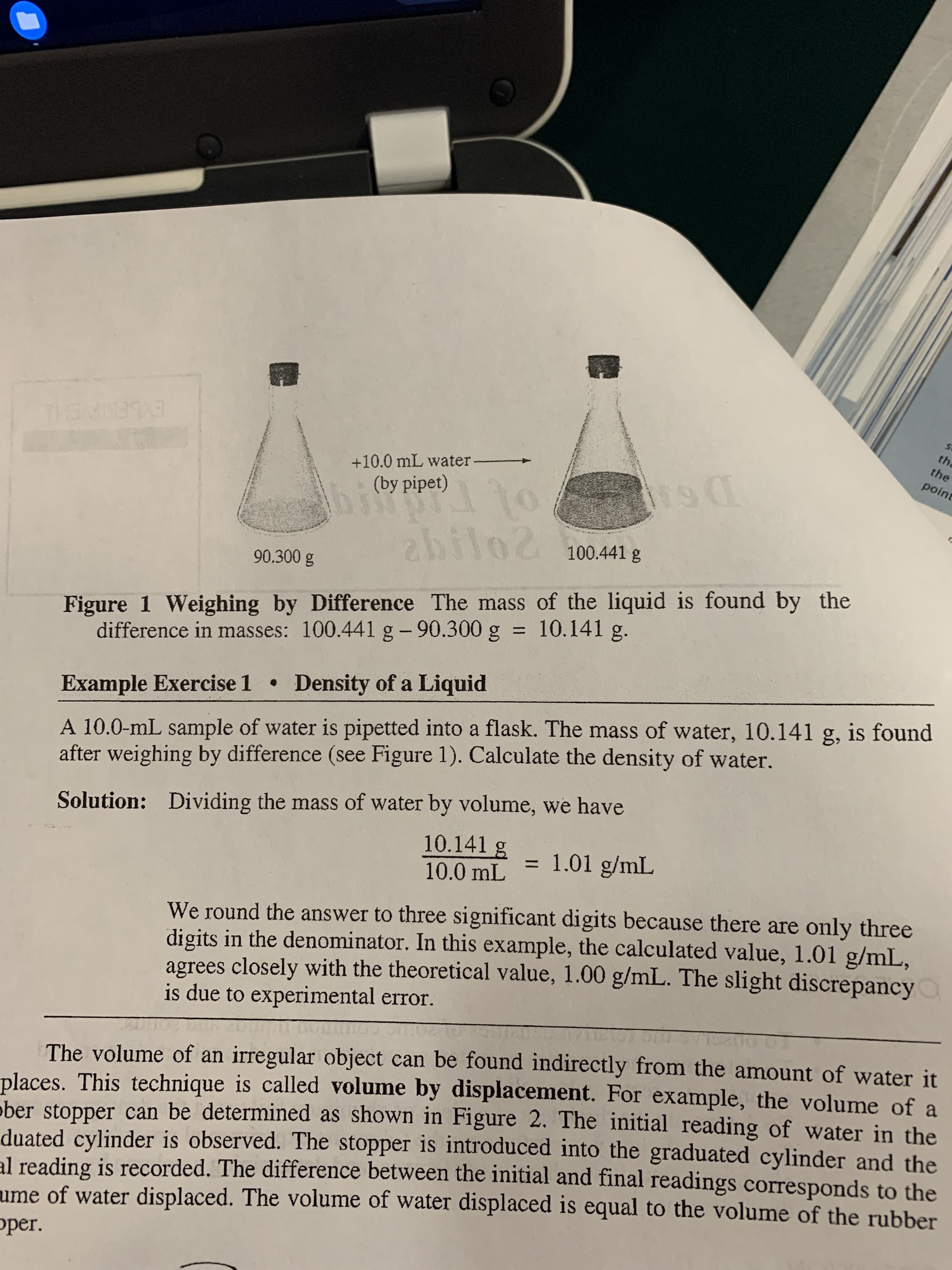THEMIS393 the the point +10.0 mL water- (by pipet) abilo2 100.441 g 90.300 g Figure 1 Weighing by Difference The mass of the liquid is found by the difference in masses: 100.441 g- 90.300 g = 10.141 g. %3D Density of a Liquid Example Exercise 1 • A 10.0-mL sample of water is pipetted into a flask. The mass of water, 10.141 g, is found after weighing by difference (see Figure 1). Calculate the density of water. Solution: Dividing the mass of water by volume, we have 10.141 g = 1.01 g/mL %3D 10.0 mL We round the answer to three significant digits because there are only three digits in the denominator. In this example, the calculated value, 1.01 g/mL, agrees closely with the theoretical value, 1.00 g/mL. The slight discrepancy is due to experimental error. The volume of an irregular object can be found indirectly from the amount of water it places. This technique is called volume by displacement. For example, the volume of a ober stopper can be determined as shown in Figure 2. The initial reading of water in the duated cylinder is observed. The stopper is introduced into the graduated cylinder and the al reading is recorded. The difference between the initial and final readings corresponds to the ume of water displaced. The volume of water displaced is equal to the volume of the rubber oper.
THEMIS393 the the point +10.0 mL water- (by pipet) abilo2 100.441 g 90.300 g Figure 1 Weighing by Difference The mass of the liquid is found by the difference in masses: 100.441 g- 90.300 g = 10.141 g. %3D Density of a Liquid Example Exercise 1 • A 10.0-mL sample of water is pipetted into a flask. The mass of water, 10.141 g, is found after weighing by difference (see Figure 1). Calculate the density of water. Solution: Dividing the mass of water by volume, we have 10.141 g = 1.01 g/mL %3D 10.0 mL We round the answer to three significant digits because there are only three digits in the denominator. In this example, the calculated value, 1.01 g/mL, agrees closely with the theoretical value, 1.00 g/mL. The slight discrepancy is due to experimental error. The volume of an irregular object can be found indirectly from the amount of water it places. This technique is called volume by displacement. For example, the volume of a ober stopper can be determined as shown in Figure 2. The initial reading of water in the duated cylinder is observed. The stopper is introduced into the graduated cylinder and the al reading is recorded. The difference between the initial and final readings corresponds to the ume of water displaced. The volume of water displaced is equal to the volume of the rubber oper.
Chemistry: Principles and Reactions
8th Edition
ISBN:9781305079373
Author:William L. Masterton, Cecile N. Hurley
Publisher:William L. Masterton, Cecile N. Hurley
Chapter1: Matter And Measurements
Section: Chapter Questions
Problem 56QAP: Magnesium chloride is an important coagulant used in the preparation of tofu from soy milk. Its...
Related questions
Question
100%
A 10.0-mL sample of alcohol is pipetted into a flask with stopper. The mass is found by difference to be 7.899 g. Refer to Example Excercise 1 and calculate the density of the liquid.

Transcribed Image Text:THEMIS393
the
the
point
+10.0 mL water-
(by pipet)
abilo2 100.441 g
90.300 g
Figure 1 Weighing by Difference The mass of the liquid is found by the
difference in masses: 100.441 g- 90.300 g = 10.141 g.
%3D
Density of a Liquid
Example Exercise 1 •
A 10.0-mL sample of water is pipetted into a flask. The mass of water, 10.141 g, is found
after weighing by difference (see Figure 1). Calculate the density of water.
Solution: Dividing the mass of water by volume, we have
10.141 g
= 1.01 g/mL
%3D
10.0 mL
We round the answer to three significant digits because there are only three
digits in the denominator. In this example, the calculated value, 1.01 g/mL,
agrees closely with the theoretical value, 1.00 g/mL. The slight discrepancy
is due to experimental error.
The volume of an irregular object can be found indirectly from the amount of water it
places. This technique is called volume by displacement. For example, the volume of a
ober stopper can be determined as shown in Figure 2. The initial reading of water in the
duated cylinder is observed. The stopper is introduced into the graduated cylinder and the
al reading is recorded. The difference between the initial and final readings corresponds to the
ume of water displaced. The volume of water displaced is equal to the volume of the rubber
oper.
Expert Solution
This question has been solved!
Explore an expertly crafted, step-by-step solution for a thorough understanding of key concepts.
This is a popular solution!
Trending now
This is a popular solution!
Step by step
Solved in 2 steps with 2 images

Knowledge Booster
Learn more about
Need a deep-dive on the concept behind this application? Look no further. Learn more about this topic, chemistry and related others by exploring similar questions and additional content below.Recommended textbooks for you

Chemistry: Principles and Reactions
Chemistry
ISBN:
9781305079373
Author:
William L. Masterton, Cecile N. Hurley
Publisher:
Cengage Learning

Chemistry: Principles and Practice
Chemistry
ISBN:
9780534420123
Author:
Daniel L. Reger, Scott R. Goode, David W. Ball, Edward Mercer
Publisher:
Cengage Learning

Chemistry: Principles and Reactions
Chemistry
ISBN:
9781305079373
Author:
William L. Masterton, Cecile N. Hurley
Publisher:
Cengage Learning

Chemistry: Principles and Practice
Chemistry
ISBN:
9780534420123
Author:
Daniel L. Reger, Scott R. Goode, David W. Ball, Edward Mercer
Publisher:
Cengage Learning